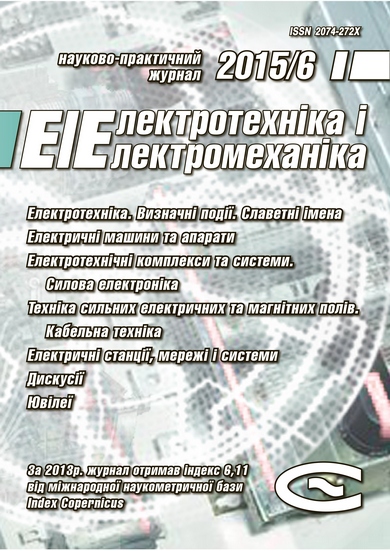A DETERMINATION OF THE FLUX DENSITY IN CORE OF DISTRIBUTION TRANSFORMERS, WHAT BUILT WITH THE COMMON USING OF GRAIN AND NON GRAIN ORIENTED MAGNETIC STEELS
DOI:
https://doi.org/10.20998/2074-272X.2015.6.05Keywords:
distribution transformer, magnetic core, grain oriented steel (GO), non grain oriented steel (NGO), flux density, no load losses, high efficiencyAbstract
Purpose. The development of calculation method to determinate the flux densities in different parts of the magnetic cores of distribution transformers, what built from different types magnetic steel (mixed core). Methodology. The method is based on the scientific positions of Theoretical Electrical Engineering – the theory of the electromagnetic field in nonlinear mediums to determine the distribution of magnetic flux in mixed core of transformer, what are using different types of steel what have the different magnetic properties. Results. The developed method gives possible to make calculation of the flux density and influence of skin effect in different parts of the magnetic cores of distribution transformer, where are used mix of grain oriented (GO) and non grain oriented (NGO) steels. Was determinate the general basic conditions for the calculation of flux density in the laminations from grain and non grain oriented steels of the magnetic core: the strength of magnetic field for the laminations of particular part of mixed core is the same; the sum of the magnetic fluxes in GO and NGO steels in particular part of mixed core is equal with the designed magnetic flux in this part of mixed core. Discover, the magnetic flux in mixed core of the transformer has specific distribution between magnetic steels. The flux density is higher in laminations from GO steel and smaller in laminations from the NGO steel. That is happened because for magnetic flux is easier pass through laminations from GO steel, what has better magnetic conductance than laminations from NGO steel. Originality. The common using of different types of magnetic steels in cores for distribution transformers gives possibility to make design of transformer with low level of no load losses, high efficiency and with optimal cost. Practical value. The determination of the flux density in different parts of magnetic core with GO and NGO steels gives possibility make accurate calculation of no load losses and magnetizing current of the transformer.
References
Levin M.I., Pentegov I.V., Rymar S.V., Lavreniuk A.V. Analysis of three-phase power transformer laminated magnetic core designs. Elektrotekhnіka і elektromekhanіka – Electrical Engineering & Electromechanics, 2014, no.1, pp. 40-44. (Rus).
Levin M.I., Pentegov I.V., Rymar S.V., Lavreniuk A.V. New approaches at construction of magnetic conductors for mains transformers. Elektrotekhnіka і elektromekhanіka – Electrical Engineering & Electromechanics, 2015, no.1, pp. 20-24. (Rus).
Levin M., Lavreniuk A.V. Economical core design for electromagnetic devices. Patent US, no.8686824, 2014.
Pentegov I.V., Rymar S.V. Method of determination of transformer iron loss for using in automated design systems. Tekhnichna elektrodynamika – Technical electrodynamics, 1995, no.6, pp. 35-40. (Rus).
Lammeraner J., Shtafl M. Vikhrevye toki [Eddy currents. Transl. with the Czech]. Moscow-Leningrad, Energiia Publ., 1967. 208 p. (Rus).
Turovskii Ya. Tekhnicheskaia elektrodinamika [Technical electrodynamics. Transl. with the polish]. Moscow, Energiia Publ., 1974. 488 p. (Rus).
Neiman L.R. Poverkhnostnyi effekt v ferromagnitnykh telakh [Surface-effect in ferromagnetic bodies]. Moscow-Leningrad, Gosenergoizdat Publ., 1949. 190 p. (Rus).
Pentegov I.V. The possibility of using the WKB-method in the study of surface effects in ferromagnetic solids. Izvestiia AN SSSR. Energetika i transport – News of USSR Academy of Sciences. Energy and Transport, 1988, no.1, pp. 127-135. (Rus).
Kiryanov D.V. MathCAD 14 [MathCAD 14]. St. Petersburg, BHV-Petersburg Publ., 2007. 704 p. (Rus).
Pentegov I.V., Rymar S.V. Method of determination of transformer iron loss for using in automated design systems a calculation method of transformer exiting current for using in automated design. Tekhnichna elektrodynamika – Technical electrodynamics, 1996, no.1, pp. 39-45. (Rus).
Downloads
Published
How to Cite
Issue
Section
License
Copyright (c) 2015 I. V. Pentegov, S. V. Rymar, Michael I. Levin, Andrii V. Lavreniuk

This work is licensed under a Creative Commons Attribution-NonCommercial 4.0 International License.
Authors who publish with this journal agree to the following terms:
1. Authors retain copyright and grant the journal right of first publication with the work simultaneously licensed under a Creative Commons Attribution License that allows others to share the work with an acknowledgement of the work's authorship and initial publication in this journal.
2. Authors are able to enter into separate, additional contractual arrangements for the non-exclusive distribution of the journal's published version of the work (e.g., post it to an institutional repository or publish it in a book), with an acknowledgement of its initial publication in this journal.
3. Authors are permitted and encouraged to post their work online (e.g., in institutional repositories or on their website) prior to and during the submission process, as it can lead to productive exchanges, as well as earlier and greater citation of published work.





